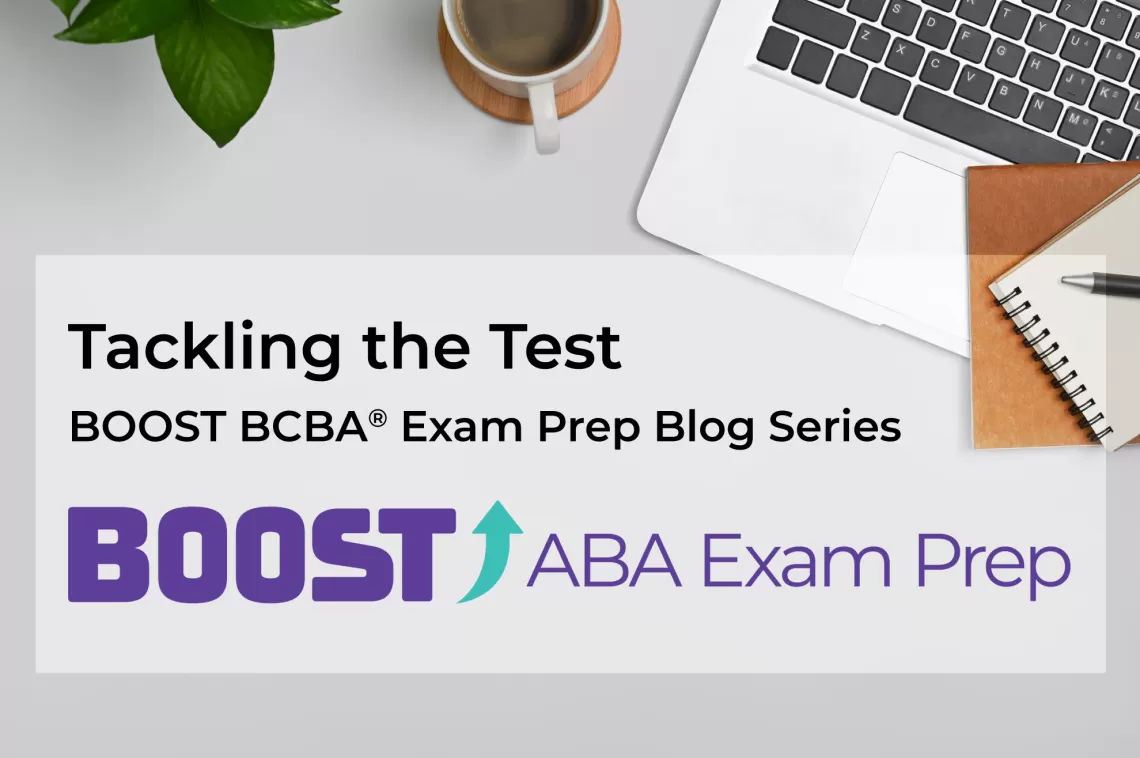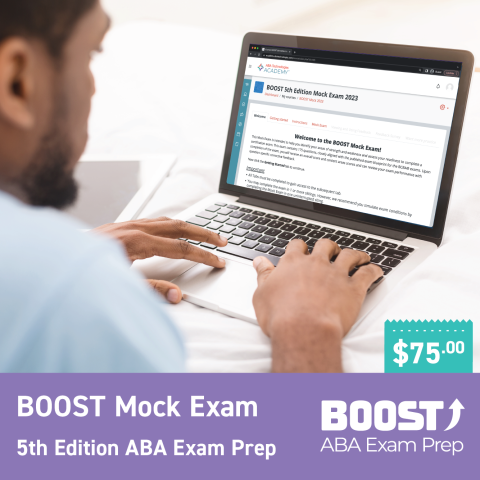
Test-taking Strategies for the BCBA® Exam - Tackling the Test Series
Part 9
Part 1: Intro to the Series
Part 2: First Steps for Preparing for the BACB® Exam
Part 3: Mock Exams for BCBA® Exam Prep
Part 4: Self-Management Strategies for BCBA® Exam Prep
Part 5: Study Methods that Work
Part 6: Beyond Rote Memorization
Part 7: 6 Ways to BOOST Your Study Time
Part 8: 10 Ways Your Friends and Family Can Help You Study for the BCBA® Exam
Part 9: Test-taking Strategies for the BCBA® Exam
Part 10: Conquering Test Anxiety with Behavioral Science
Tests are an important and inevitable part of becoming a behavior analyst. Whether within coursework or, eventually, the certification exam, tests can induce a mix of anticipation, stress, and a slew of private and public events we may describe as “anxiety.”
Having effective test-taking strategies in your arsenal can significantly boost your performance and help mitigate the effects of anxiety. In this blog, we will explore test structure and how to analyze scenario questions, and we will offer some test-taking strategies to help you confidently approach the BCBA® exam.
Understanding the BCBA® Exam
The BCBA exam consists of 185 multiple-choice questions. Ten are unscored, while 175 are scored. One-hundred-seventy-five of these are scored items, and ten of these are unscored. Four answer choices are available for each item, with only one correct answer. Familiarizing yourself with the exam development, format, rules, scoring, and facts about the exam will allow you to enter the test informed and confidently as an informed consumer.
Before the BCBA® Exam

The foundation of successful test performance lies in preparation and planning. For behavior analysis students, much of the preparation for the BACB® exams should occur during their coursework and fieldwork experience. But learning does not stop once you leave the classroom. These tips will serve you well as you prepare for the BACB® exams:
- Identify your strengths and weaknesses via quality mock exams, and begin studying well in advance. Last-minute cramming can be counterproductive.
- Create a self-management exam prep plan, including a study schedule, break down the material into manageable chunks, and allocate sufficient time for each content area. Establish a routine that will ensure that you cover all necessary content.
- Use effective study strategies and quality resources.
Using Behavioral Momentum on Exam Day
Multiple-choice questions can sometimes feel tricky, but the aim of the BACB® exam isn’t to mislead you. Rather, the aim is to determine if you have mastered the necessary discriminations. However, multiple-choice items do require careful attention. Time management is crucial during a test. Use your time effectively, take advantage of behavioral momentum, and boost your confidence with little wins. It may help you to take three passes through your exam by following this test-taking strategy:
Pass 1: Answer the “easy” ones first. Starting with the first question, proceed through the exam, answering questions you know. These are the items you can answer quickly and with confidence. If you must think about a question too long or are not confident in your answer, don’t let it bog you down. Keep momentum by flagging the item and moving on.
Pass 2: Go back through your flags. Once you have answered all the easy items, go through your flags. This pass, spend a bit more time with each item. If you really don’t know it, keep it flagged and move on again.
Pass 3: Finish the exam… By the third pass, you should have only a few questions left. Spend most of the remaining time working through the most challenging items.
Review. If time allows, go through the test one more time, reviewing all items to ensure you are confident with your answers. Be careful not to overthink. Some students are prone to changing too many items at this point, and this second-guessing hurts their scores.
This strategy works for many students, but not everyone benefits from this 3-pass process. To see if it is an effective strategy for you, try it out prior to exam day on a high-quality mock exam. This will allow you to practice the strategy and evaluate if it is effective for you.
Seven Steps for Analyzing Exam Items
Responding to a multiple-choice question is a bit like being a detective: the answer is there in front of you, hidden among a variety of distracting information, and it is up to you to find it. This doesn’t mean that items are meant to be tricky; it means that each item will ask you to make a relevant discrimination. You will be asked to use the information in the question to make the discrimination. Taking a step-by-step approach can help solve each case:
- Read the question carefully twice. Yes, twice! Missing one word can change the context of the question. Avoid adding information that isn’t written in black and white, and don’t make assumptions about information that is not present in the questions. Identify what the question is asking and what skill it is testing.
- Read the question carefully twice. Yes, we are serious enough to list this twice. Do yourself a favor and do it!
- Diagram and label. Diagram the example or write what you know. The task here is to extract the relevant information. There may be superfluous information in the item. You will need to sift through to find the important vs. irrelevant information. Here’s an example of diagramming:

- What is the question asking?
- Who is the behavER? Identify whose behavior we are focused on.
- What is the behavIOR? What is the target behavior or responses?
- Identify relevant information given the question type and content.
- Extract and label information relevant to the question. Remember not to make assumptions or add information that isn’t given.
- Return to the question and answer it yourself. Once everything is labeled, return to what the question is asking. You likely have already labeled it. Answer the question for yourself before looking at the answer choices.
- Read all the answer choices. Once you know the answer, look at the given choices to identify the one that best matches your answer. Be sure to read every answer choice and select the best answer.
- Process of elimination or play the 50/50. Eliminate any obviously incorrect answers to narrow down your choices, increasing your odds of selecting the correct one if you must guess.
- Flag and move on. If you're unsure, flag the item and come back to it with fresh eyes. Avoid overthinking or second-guessing. If it is your last pass, make an educated guess rather than leaving it blank.
Extracting Relevant Information
Extracting relevant information from exam questions often involves asking yourself questions about the content. The type of questions you need to ask when analyzing an exam item will differ based on the content of the question itself. For example, if the question is a scenario and you need to identify the specific type of antecedent or consequence exemplified, you may need to ask questions like the following:
- What are the relevant consequences for the behaver? Classify them as reinforcement or punishment, positive or negative.
- What are the relevant antecedents, and how do they function in relation to the consequences? Do they “signal” availability (discriminative stimuli), or do they alter the value of a consequence (motivating operations)?
Additional relevant questions for this type of question can be found here.
Graph questions or questions requiring you to make a clinical decision will require you to ask a different set of questions and label items within the question differently. For example, you may first need to identify/label:
- The type of graph
- The experimental design
- If there was a change in behavior (yes/no)
- Did behavior increase or decrease after the implementation of the intervention?
- If a change occurred, where/when did it occur?
- Did a behavior change follow a change in conditions/treatment?
- Was there a demonstration of experimental control?
Again, knowledge of the content will offer clues to the questions you must ask. Being able to ask yourself these questions while working through exam items and labeling what you know as you go will help you select the correct answer.
Mastering Exam Strategies
Performing well on any test or exam is about knowledge of the subject matter and implementing effective strategies during the exam. The first step is mastering the concepts, principles, and technologies of ABA during coursework and supervised fieldwork. Reviewing materials to strengthen any deficits in comprehension is important in the period between finishing coursework and supervision and sitting for the exam. The night prior and the exam, it is important to achieve a calm, steady state of mind and body to perform your best. Finally, read carefully during the exam and attack each question intentionally. The combination of preparing thoroughly, understanding the test format, staying organized, managing time effectively, and using appropriate techniques will help you to perform your best.
Find the right BOOST Product for you

